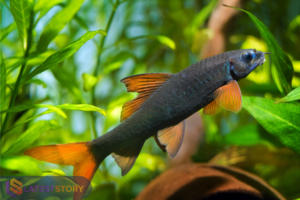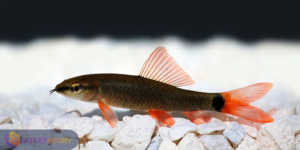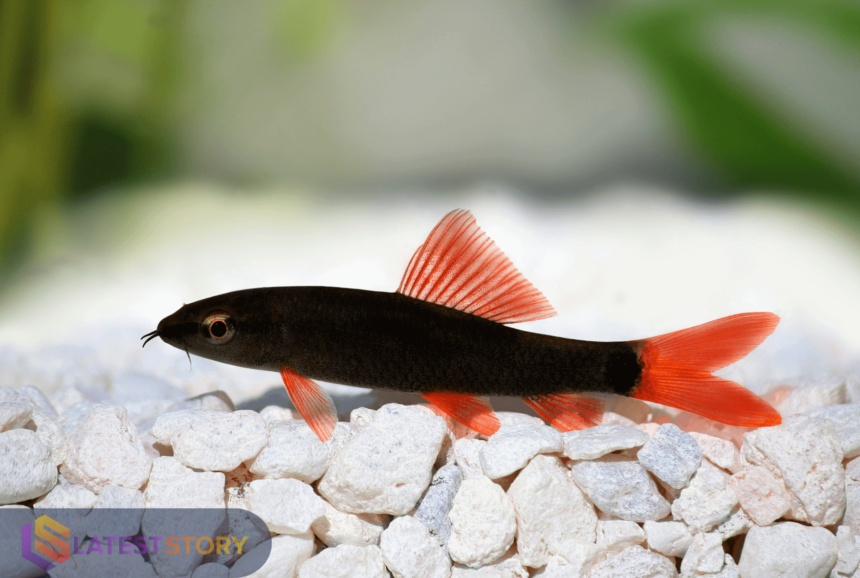The rainbow shark is a stunning freshwater fish that attracts many aquarium hobbyists due to its unique appearance and active personality. This fish, with its elongated body and striking red fins, can add a dynamic presence to any tank. However, before introducing a rainbow shark to your aquarium, it’s crucial to understand its habitat, diet, behavior, and compatibility with other fish.
Rainbow Shark Bio Table
| Feature | Details |
|---|---|
| Scientific Name | Epalzeorhynchos frenatum |
| Common Name | Rainbow Shark |
| Lifespan | 5-8 years |
| Size | Up to 6 inches |
| Temperament | Semi-aggressive |
| Diet | Omnivore |
| Tank Size | Minimum 50 gallons |
| Water Temperature | 72-79°F (22-26°C) |
| pH Level | 6.5-7.5 |
| Tank Mates | Non-aggressive, mid-to-top dwellers |
Rainbow Shark Overview
Rainbow sharks are native to the rivers of Southeast Asia, including Thailand and Laos. They are bottom dwellers that prefer spacious environments with plenty of hiding spots. While these fish are peaceful when young, they tend to develop territorial aggression as they mature.
Ideal Tank Setup for a Rainbow Shark
Setting up the right environment is key to keeping your rainbow shark healthy and stress-free.
1. Tank Size
A minimum of 50 gallons is recommended for a single rainbow shark. If you plan to keep more than one, a larger tank (100+ gallons) is necessary to prevent territorial disputes.
2. Water Conditions
- Temperature: 72-79°F (22-26°C)
- pH Level: 6.5-7.5
- Hardness: 5-11 dGH Maintaining stable water conditions is vital to keeping your rainbow shark stress-free and healthy.

3. Filtration and Oxygenation

3. Filtration and Oxygenation
Rainbow sharks thrive in clean, well-oxygenated water. A high-quality filter with a strong current helps replicate their natural habitat. Regular water changes (25% weekly) help maintain water quality.
4. Substrate and Decorations
- Use fine gravel or sand as a substrate to prevent injuries.
- Provide hiding spots using caves, driftwood, and rocks to reduce stress.
- Live plants like Anubias, Java Fern, and Amazon Sword help create a more natural environment.
Diet and Feeding Requirements
Rainbow sharks are omnivores, meaning they eat both plant and animal matter. A balanced diet ensures their vibrant coloration and overall health.
Recommended Diet:
High-quality sinking pellets or wafers
Live/frozen foods like bloodworms, brine shrimp, and daphnia
Fresh vegetables such as blanched zucchini, peas, and lettuce
Algae wafers to mimic their natural grazing behavior
Feed them once or twice a day, ensuring they consume all food within 2-3 minutes to prevent overfeeding and tank pollution.
Behavior and Temperament
While rainbow sharks may seem peaceful at first, they can become territorial as they grow.
Common Behavioral Traits:
- Territorial nature: They claim specific areas in the tank and chase away intruders.
- Active swimmers: Constantly exploring and patrolling their territory.
- Solitary lifestyle: Prefer to be alone rather than in groups of their kind.
To reduce aggression, provide adequate space, hiding spots, and compatible tank mates.
Compatible Tank Mates
Choosing the right tank mates is essential to maintaining peace in your aquarium.
Good Tank Mates:
Peaceful, mid-to-top dwellers (e.g., tetras, barbs, gouramis)
Bottom dwellers that are not aggressive (e.g., corydoras catfish, plecos)
Fast swimmers that can escape aggression
Tank Mates to Avoid:
Other rainbow sharks or similar species (aggression risk)
Slow-moving fish (e.g., goldfish, bettas)
Aggressive fish like cichlids
If keeping multiple rainbow sharks, provide a tank over 100 gallons with plenty of separate hiding spots.
Breeding Rainbow Sharks
Rainbow sharks are difficult to breed in home aquariums due to their aggressive nature. In the wild, they spawn in riverbeds during monsoon seasons, which is hard to replicate in a tank setting. Most rainbow sharks available in pet stores are bred in commercial fish farms using hormone treatments.
Common Health Issues
Like any fish, rainbow sharks are prone to certain diseases.
1. Ich (White Spot Disease)
- Symptoms: White spots on the body, rubbing against objects.
- Treatment: Raise water temperature to 82°F and use anti-ich medication.
2. Fin Rot
- Symptoms: Fins appearing frayed or discolored.
- Treatment: Improve water quality, use antibacterial medication.
3. Swim Bladder Disease
- Symptoms: Difficulty swimming, floating upside down.
- Treatment: Adjust diet, feed blanched peas to aid digestion.
Tip: Maintaining clean water and a proper diet is the best way to prevent diseases.
Conclusion
The rainbow shark is a beautiful yet semi-aggressive fish that requires a large, well-maintained aquarium to thrive. By providing the right environment, a balanced diet, and choosing compatible tank mates, you can enjoy their striking colors and active nature for years. Whether you’re a beginner or an experienced aquarist, understanding the unique needs of rainbow sharks will help ensure a healthy and harmonious tank.

FAQs

FAQs
1. How big do rainbow sharks get?
They grow up to 6 inches in length when fully mature.
2. Can you keep multiple rainbow sharks in the same tank?
It’s not recommended unless the tank is over 100 gallons with plenty of separate hiding spaces.
3. Are rainbow sharks aggressive?
Yes, they can be territorial and may chase other fish, especially bottom dwellers.
4. What is the best diet for rainbow sharks?
A mix of sinking pellets, live/frozen foods, and vegetables ensures a healthy diet.
5. How long do rainbow sharks live?
They typically live 5-8 years with proper care.
6. Can rainbow sharks live with bettas?
No, bettas are slow-moving and may get harassed by the rainbow shark.
7. Do rainbow sharks need a filter?
Yes, a strong filter is necessary to keep the water clean and well-oxygenated.
8. How often should I feed my rainbow shark?
Feed them once or twice a day, ensuring all food is consumed within 2-3 minutes.






